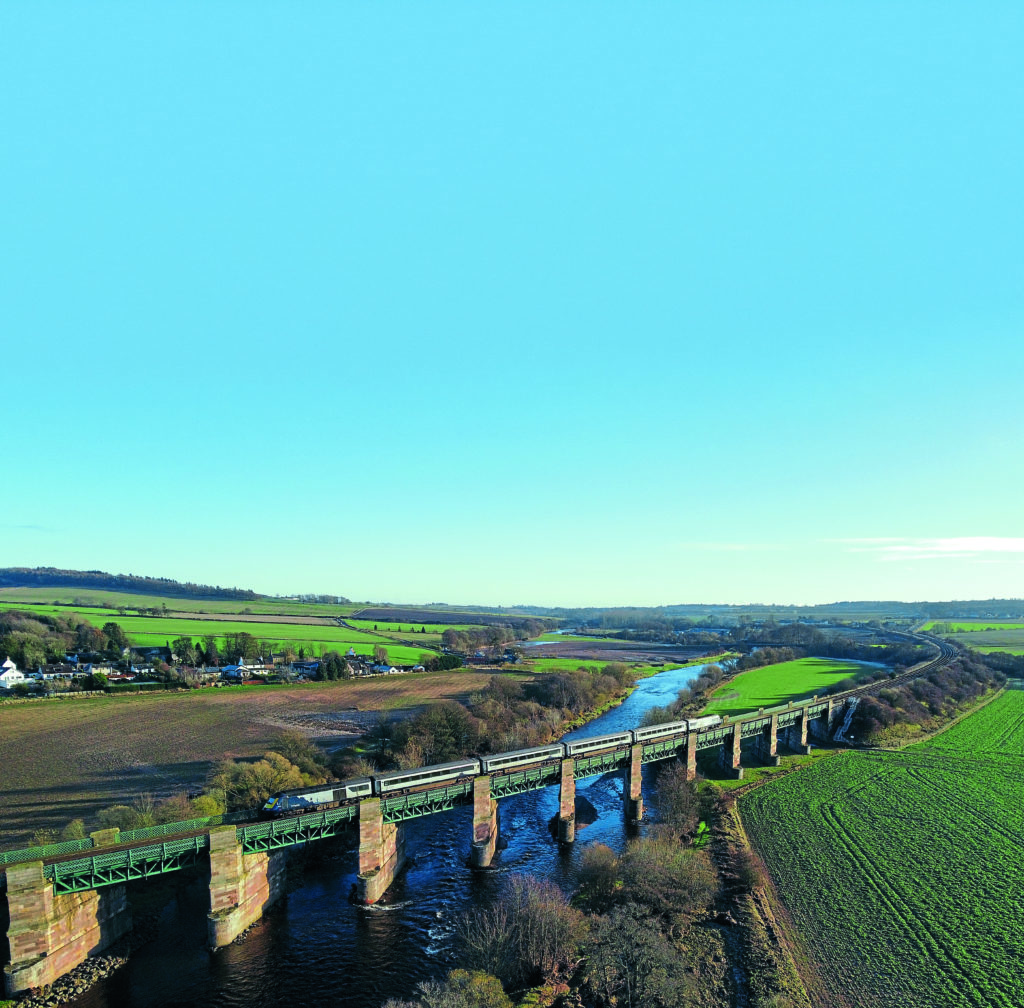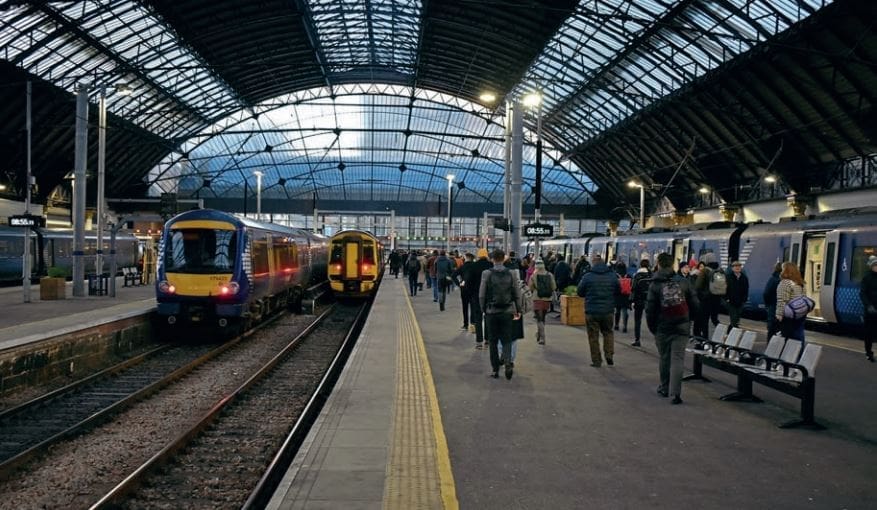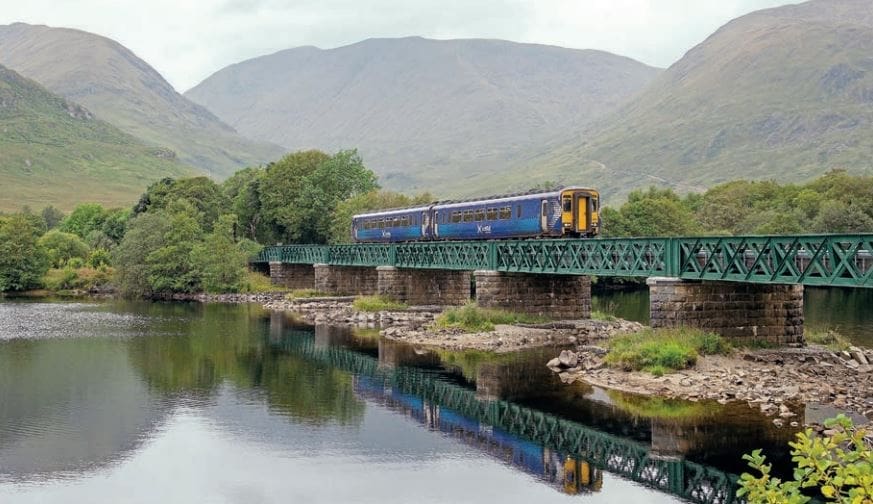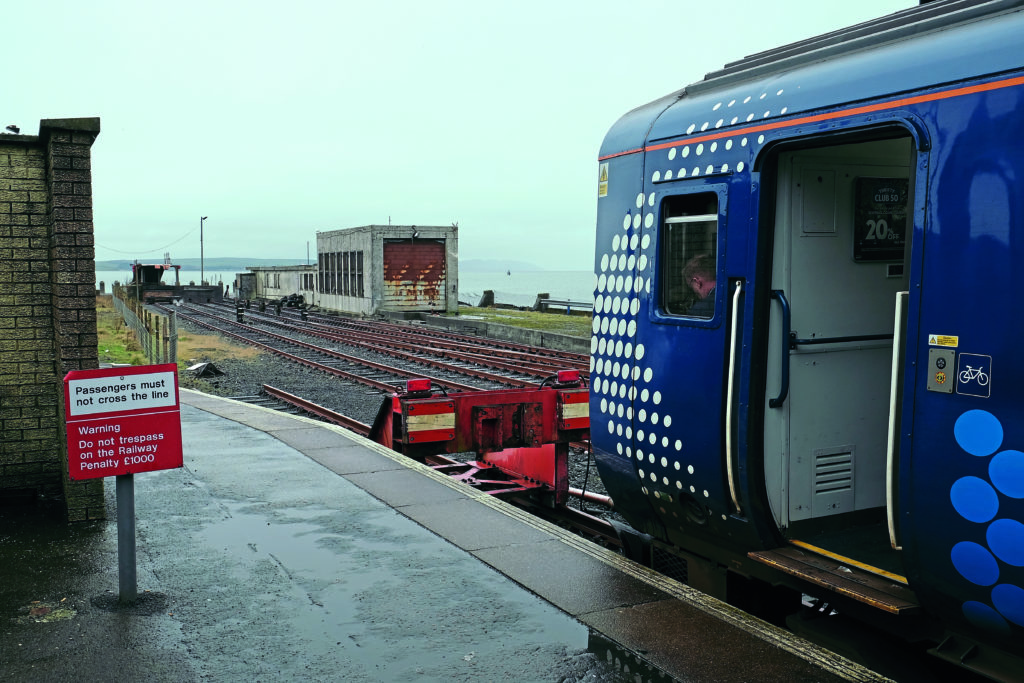ScotRail service delivery director David Simpson talks exclusively to Richard Clinnick about new trains planned for Scotland what this means for the existing fleets.

Decarbonisation and new trains look set to dominate Scotland’s Railways over the next decade. This is not the first time the railway north of the border has looked to operate differently from the rest of the country. The use of redundant, refurbished High Speed Trains on inter-city services at the same time other operators were opting for underfloor-engined fleets is a prime example. Both the UK and Scottish governments have plans for decarbonising the railways, with deadlines set by the pair. However, the deadlines differ, with the Scottish date of 2035 more challenging than the UK’s 2050 deadline, albeit the latter wants rid of diesel-only trains by 2040.
This means ScotRail’s current fleet
will need changing. Including all the various sub-classes, ScotRail operates 14 fleets. These are: Class 153, 156, 158, 170/3 and 170/4 diesel multiple units, Class 318, 320/3, 320/4, 334, 380/0, 380/1, 385/0 and 385/1 electric multiple units and the Inter7City HSTs.
Enjoy more Rail Express Magazine reading every month.
Click here to subscribe & save.
Currently these trains can be found across the country. The five Class 153s are used on the West Highland Line from Glasgow Queen Street to Oban, operating paired with a Class 156. They offer extra luggage and bicycle space and feature Wi-Fi, USB ports and tables. Passengers are also able to sample food aboard the ‘153s’ as well. Currently two of the five are in use per day, and from this year the plan is for them to start serving Mallaig. They are based at Corkerhill.
The two-car Class 156 fleet is one of the workhorses of ScotRail fleet and can be found across Scotland, as well as on routes into England. The trains operate on diesel services from both Glasgow Central and Glasgow Queen Street, on the WHL to Oban, Fort William and Mallaig and to Stranraer. These are also based at Corkerhill.
The two-car Class 158 fleet can also be found across Scotland. There are some duties in the Glasgow area, but they can be found operating from Edinburgh to destinations across the Central Belt, in and around Aberdeen and across the Far North. Allocations are split between Inverness and Corkerhill, although those based at the Highland depot can be found in Glasgow.
Just like most of the Class 156s and 158s, the Class 170s have been in Scotland since they were first delivered. They have been displaced from several duties in recent years including the Glasgow Queen Street-Edinburgh Waverley via Falkirk High (E to G) and many express services between the seven cities (now eight) meaning they are found on some local services. They also operate most Borders services, however, their main sphere of operation remains from Glasgow Queen Street and Edinburgh Waverley to Aberdeen and Inverness. Following expiry of leases, some sets have been transferred away in recent years, moving to East Midlands Railway, Northern and Southern but there are no plans now for any more to leave prior to the delivery of new trains. The Class 170s are allocated to Haymarket.
Within the EMU fleet, the three-car Class 318s operate across the Strathclyde network, operating solo, in pairs, or paired with Class 320s. They date from the mid-1980s and were replaced on Ayrshire coast services by the Class 334s, which enabled them to replace the famous ‘Blue Train’ Class 303s on more suburban duties, where they have remained ever since. These are based at Glasgow Shields Road and have operated in Scotland for their entire career.
The original 22 three-car Class 320/3s have been bolstered by the arrival of 12 Class 320/4s converted from four-car Class 321/4s between 2014 and 2019. These had a vehicle removed and were sent north to boost capacity in the Strathclyde region. The Class 320s can be found operating solo, in pairs, in multiple with each sub-class, and can also operate with Class 318s. They are based at Glasgow Shields Road.
The next EMU fleet is the Class 334s. Built by Alstom, the three-car trains suffered a delayed introduction and began carrying passengers later than planned in 2001. They were introduced on services from Glasgow Central to the Ayrshire Coast, replacing the 318s, and also operated Strathclyde suburban services. When the Airdrie to Bathgate line (A to B) reopened in 2010, they were cascaded to that, operating pairs, and were eventually replaced on the Ayrshire Coast by Class 380s. Today they can be found on the A to B route and suburban services through Glasgow Central Low Level, although they no longer operate from the main station. The trains are based at Glasgow Shields Road and have not left Scotland since delivery, not even for maintenance.
Siemens delivered the Class 380s from 2010 – these were a development of the Desiros in use elsewhere in the UK and Europe, but not the full evolution as per the Desiro City (Class 700/707/717 fleets). They were also the first Siemens-built fleet in the UK not to have a purpose-built depot, without being maintained entirely by the manufacturer.
The fleet was introduced onto the Ayrshire Coast, Glasgow Central-Edinburgh Waverley and North Berwick routes. When the Class 385 introduction on the E to G line was delayed, ScotRail used the short-term ‘365s’ and ‘380s’ in their place. Today they no longer operate on the core route via Falkirk but can be found on many other duties they have operated on since their introduction. These are also based at Glasgow Shields Road.
Hitachi built 70 Class 385s and these were built in 2016-2019 and accepted between 2018-2019. Their introduction was further delayed for a number of issues identified during acceptance to be resolved. They were introduced on routes newly electrified as part of the Edinburgh to Glasgow Improvement Programme (EGIP) and can be found operating trains between Edinburgh and Glasgow via the E to G, Shotts and Carstairs route. They also serve North Berwick, Dunbar, Dunblane, Alloa and Cumbernauld. The trains are allocated to Craigentinny with maintenance undertaken by Hitachi (which also maintains Class 800-803 fleets at the depot), with a stabling facility at Millerhill. Recent figures have shown the trains to be the most reliable in Britain, recording 120,000 miles per technical incident (MTIN).
Finally, there is the IC7 fleet. This is made-up of former Great Western Railway HSTs made redundant following the introduction of Class 800/802 Intercity Express Trains. The idea behind the HSTs was to create an InterCity-style feel for services between Scotland’s seven cities (there are now eight after Dunfermline was awarded the status, however, HSTs do not serve the city), offering increased capacity and a smoother ride by replacing underfloor-engined vehicles with coaching stock.

To meet accessibility regulations the Mk 3s would be fitted with sliding doors and other modifications. However, the rebuild took longer than anticipated, with the first HST entering traffic in 2018 when the first refurbished sets began operating. ScotRail also used ‘Classic’ sets which had not been modified and were to be withdrawn as early as possible. These have since all been scrapped.
When Abellio took over the ScotRail franchise in April 2015, the plan was for 17 five-coach and nine four-coach IC7s, with the possibility that all 26 could eventually be five-coach sets. However, the pandemic has affected passenger numbers. One set, HA22, was written off in the Carmont tragedy on August 12, 2020, with both power cars, Nos. 43030 and 43140, also scrapped. There are no plans to replace them. Two other HST power cars, Nos. 43018 and 43185, were picked clean of spares by Haymarket, which maintains the IC7s, before they were disposed of. The former has been preserved at Crewe Heritage Centre; the latter is at Brodie Engineering in Kilmarnock.
Currently ScotRail requires 15 of the 25 IC7 sets in traffic each day. There are five five-coach sets in service, although all the additional Mk 3s have been delivered with the majority stored at Slateford. The plan is to extend them as patronage returns but there remains some infrastructure obstacles such as short platforms at Inverness. Currently only two platforms can accommodate five-coach IC7s at the Highland station. However, a project is underway to identify cost-effective solutions to this problem, which will allow more flexibility in diagramming five-coach sets.
A steering group has also been created involving the trade unions and Angel Trains, which owns the IC7, to tackle safety issues raised following the Carmont tragedy. There are discussions over the crashworthiness of the fleet, aimed at addressing points raised in the Carmont RAIB report. Talks are ongoing and are reported as constructive.
What this means is that ScotRail has a fleet of 52 Class 43 power cars, 117 Mk 3s, 121 DMUs and 202 EMUs. Office of Rail and Road (ORR) figures released in October 2022 revealed that ScotRail’s fleet is the sixth oldest in Britain, with an average age of 22.2 years for the period April 1 2021 to March 31, 2022. This has risen by 0.6 years. In comparison, the average age of Britain’s train fleet is 16.9 years.
ScotRail operates the oldest production HST power car left on the main line (No. 43003) and some of the youngest EMUs, however, much of its fleet is second-generation EMUs, Sprinters and the first generation of DMUs ordered during privatisation.
It means change is needed, and change is planned. When announcing more electrification in June 2022, Scottish Transport Minister Jenny Gilruth announced plans to replace fleets approaching life expiry.
Speaking to RE in Glasgow on December 8, ScotRail service delivery director David Simpson explained that the current plan for new trains was backed by Holyrood’s desire for decarbonisation and the need to replace life-expired trains. Final decisions on procurement and funding have yet to be taken, but a robust plan which ties in with Network Rail’s decarbonisation plans is being developed.
He says that the new trains will be split into three fleet: Suburban, inter-city and rural. The only guarantee is that none will be purely diesel-powered. It’s expected that the suburban fleet will be a mixture of pure EMU and BEMU fleets (battery powered).
“The first trains will be delivered between 2027 and 2029 and they will be part of the suburban fleet. The last trains will be delivered by 2035 with the last fleet to be withdrawn probably being the Class 170s,” he explains.
However, it’s not a simple case of introducing a new fleet onto a route and sending the trains they are replacing to another operator, or for scrap. Instead, David explains that the new fleet will in some cases be a direct replacement for existing fleets, and in others initiate a cascade within the fleet. He cites the introduction of BEMUs on certain routes, replacing Class 156s, which would enable Class 158s to operate on the WHL. This would require infrastructure work but doing that early enables a seamless introduction of new trains.

Within the EMU fleet, the first fleets to be withdrawn will be the Class 318s and 320s which are deemed life-expired; however, the current plan is that the Class 380s and 385s will be retained and will continue operating on existing routes. The new fleets will instead be introduced onto Strathclyde suburban routes, A to B and routes about to be electrified including East Kilbride. There is, as yet, also no firm decision on the future of the ‘334s’.
The Scottish government has a plan to roll out electrification across much of Scotland, including from Ayr to Girvan as well as across the Highlands. Plans are set out in Transport Scotland’s Rail Services Decarbonisation Action Plan, which the rolling stock strategy is closely linked to.
As for the Bi-mode EMUs, no decisions have yet been taken on the alternative power mode, although ScotRail supported the Arcola Energy hydrogen-powered Class 614 (converted from ex-ScotRail No. 314209) during its trials at the Bo’ness & Kinneil Railway.
These trials are complete, and the Class 614 is to be decommissioned. Likewise, says David, it is not yet clear exactly when ScotRail will go to the market, meaning rumours RE had heard suggesting certain manufacturers were in with a chance are mere speculation. However, if ScotRail was to go to market in 2023, that would give any bidder, realistically, three to four years to develop, design, build and deliver a fleet. One specification David says is non-negotiable for the suburban fleet is that they must all be equipped with level-boarding access.
Interiors will be market-driven. “They will need to attract various markets including tourism, leisure and hospitality – they need to be fully inclusive, and family friendly. There is a huge potential,” says David, who confirms that there will be a consultation period and that the Scottish transport minister has a conversation for rail planned for this year.
Another key factor is expected to be the vehicle length, he says. “If you look at the suburban trains, we currently run a mix of three and six-car trains. Could we therefore operate a fixed-formation five-car train that is the same length as the six-car formations running today?” A Class 318 is 59.58 metres long, a Class 320 is 59.85m and a 334 is 61.96m. That would suggest new five-car trains could have 24m-long vehicles. There will also not be front end gangways on these trains, he says.
“Don’t forget that we don’t think we’ll have the same peaks as before. The trains are sized based on 2019 demand levels, but the pattern of post-pandemic flows has changed,” he says, and cites that peaks have changed, with 240,000 people travelling during the busiest periods at weekends, and only 200,000 on weekdays.
Asked by RE if that is a risky strategy with many operators still unsure what the post-pandemic travel patterns will be, David says: “You could adjust timetables if people come back but the great thing about being publicly owned is that we can think long-term rather than by franchise lengths. We get the revenue and can invest it; it doesn’t go elsewhere.”
As for what trains could be delivered, Southeastern recently went to the market and asked for new-build trains but with a proven record in the UK. Will that be the case for ScotRail? “We’re open to anyone, really,” says David. No decision has yet been made on where the trains would be maintained, or if the manufacturer will carry out maintenance, although it is expected that depots will need to be modified for new trains, but that is usually the case anyway. “Glasgow Shields Road will feature strongly,” he says. The issue for any fleet is stabling facilities rather than maintenance – the IC7 introduction has shown this for example with the need for new facilities at Cadder and Slateford. However, it is expected that the new trains will require less maintenance.

While BEMUs are expected for the suburban routes, could locomotive-hauled trains be used for the IC7 replacements? “We are open to ideas, although units are more likely than locomotives and stock,” admits David. Another consideration is that Glasgow Queen Street can only take an eight-coach train, and it may be waste to have a locomotive as one vehicle.
The rural fleet will be deployed on the WHL, Stranraer, Far North Line and Kyle of Lochalsh routes. The traction package is not decided but will best reflect available technology at the point these trains are procured. As for when the new fleets arrive, internal cascades begin and withdrawal of current fleets is due to begin, David explains the current thinking.
One DMU, No. 156478, has already been sent off-lease. Owned by Brodie Engineering Ltd, the two-car train was returned to its owners in May due to the reduced passenger numbers. No more withdrawals are planned until around 2027 when the first Class 156s will be sent off-lease.
The first EMUs to go will be the 318s and 320s, although in what order isn’t confirmed. David says that both fleets currently have good interiors and are reliable, however, they are 36 and 32 years old respectively and so are reaching life-expiry.
Finally, the IC7s are expected to be in traffic until towards the end of the fleet replacement strategy, subject to a satisfactory outcome with the steering group. The power cars are currently undergoing their first G-exams at Haymarket since moving to Scotland and these involve a major rebuild and component replacement.
All this means there’s an exciting future for Scotland’s Railways. A clear strategy for decarbonisation has led to a clear fleet plan. Who would have thought that would be a recipe for success?

ScotRail fleet, correct to January 1, 2023
- Class 43: 43003/012/015/021/026/028/031-037, 43124-139/141-152/163/164/168/169/175-177/179/181-183
- Class 153: 153305/370/377/380/382
- Class 156: 156430-437/439/442/445/446/450/453/456-458/462/467/474/476/477/492-495/499-514
- Class 158: 158701-736/738-741
- Class 170: 170393-396, 170401-415/425-434/450-452/470/471
- Class 318: 318250-318270
- Class 320: 320301-320322, 320401/403/404/411-418/420
- Class 334: 334001-334040
- Class 380: 380001-380022, 380101-380116
- Class 385: 385001-385046, 385101-385124
- Mk 3 coaches: 40601-40621/623-626, 42004/009/010/012
014/019/021/023/029/030/032-035/045
047/054-056/072/075/077/078/096,42107/129/143/144/183
185, 42200/206-209/245/250/252/253/255-257/259/265/267
269/275-277/279/280/281/288/291-293/295-297/299,
42300/301/313/325/333/343/345/350/351/360,
42551/553/555/557-559/561/562/567/568/571/574-579/581.
Note: No. 43128 has never been used by ScotRail.
No. 156478 has been returned to Brodie Leasing.
In RE322 (March) we visit Haymarket depot for an exclusive look at how the IC7 sets are maintained. It’s available to order here.




